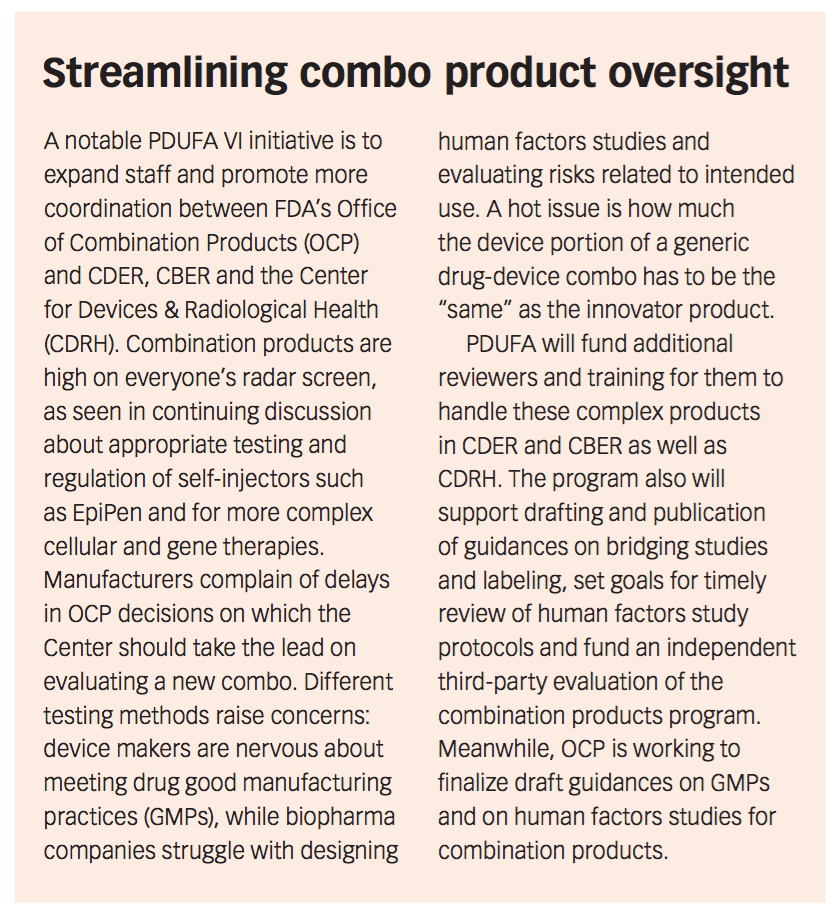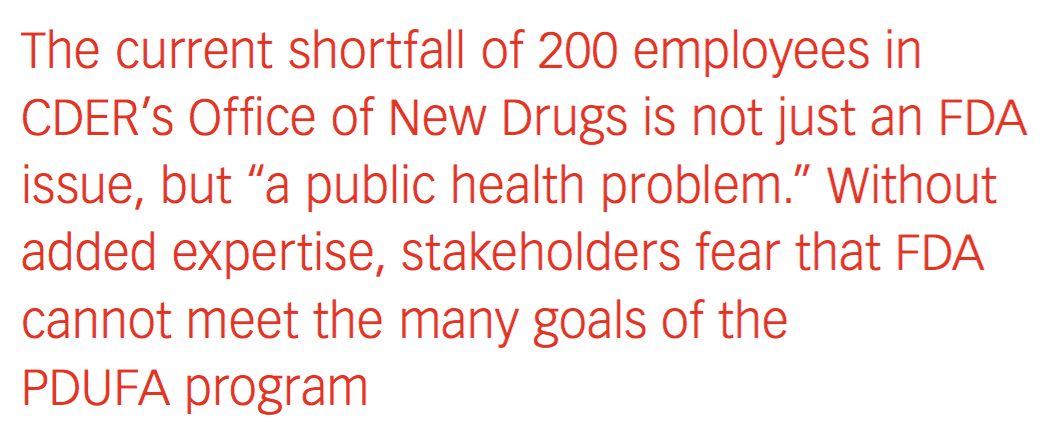Major Changes Ahead for Drug User Fees
Pharmaceutical Executive
PDUFA VI to enhance FDA staffing, revise fees and expand evidence for drug development.
Congress has less than a year to approve the revised Prescription Drug User Fee Act (PDUFA VI), a process complicated by a change in administration in January that will delay Congressional consideration of new programs and policies for several months. That will bring the reauthorization process close to when current fees for drugs and
Jill Wechsler

biologics, along with similar programs for biosimilars, medical devices and generic drugs, expire Sept. 30, 2017. So FDA and biopharma companies are lining up support from patient groups and health professionals to move the process along as fast as possible.
The agreed-on PDUFA VI “commitment letter,” which was discussed at a public meeting in August, maps out strategies for making the program less burdensome and complex, while also expediting the assessment of innovative products. More emphasis on “hearing the patient voice” will bolster development of breakthrough therapies and treatments for rare diseases, enhanced by broader use of innovative clinical trial designs and biomarkers. FDA will hold public workshops and develop a series of guidances for collecting patient input on disease burden, treatment impact and clinical outcomes assessment, with an eye to expanding reviewer understanding of the benefits--as well as the risks--of a test therapy to patients.
Related initiatives aim to further incorporate real-world evidence and benefit-risk assessment into drug development so that these approaches can be utilized more in evaluating efficacy, in addition to tracking safety issues postapproval. FDA also will expand its Sentinel System to enhance drug safety monitoring, with an eye to broadening use of health system data for clinical development. Important for sponsors is a related provision promising timely, advance communication to manufacturers on emerging safety signals.
More predictable fees
These and other initiatives will be supported by notable revisions in the PDUFA fee structure. A new “program” fee will replace current levies on manufacturing facilities and on products. It will be calculated to yield 80% of the anticipated $1.2 billion collected by PDUFA in 2018; application fees will add up to only 20% of program cost, reducing FDA reliance on revenues that can vary from year to year.
A related change is to drop user fees altogether for efficacy and manufacturing supplements. These levies are difficult for FDA to administer and don’t add up to much revenue. And the revision could encourage sponsors to update labeling on a more timely basis and to pursue quality improvements in production systems.
The shift away from facility fees reflects industry’s expanded use of contract manufacturers for drug production, which makes it difficult to assess the portion of a production site allotted to each pharmaceutical client. The new program fee will be based on the number of approved drugs and biotech therapies marketed by a firm. However, it will apply to only the first five versions of the same drug to avoid discouraging development of personalized therapies that may have five, 10 or more different formulations.
There is some concern that larger fees on marketed products could lead pharma companies to drop older drugs that are only marginally profitable. Nevertheless, manufacturers and FDA are optimistic that the new fee structure will be more predictable for all parties and will support a more sustainable and manageable program.
At the same time, PDUFA VI puts more pressure on manufacturers to fully prepare and identify relevant production sites before submitting a new drug application (NDA) or biologics license application (BLA) or supplement. The user fee program sets increasingly short time frames for the Center for Drug Evaluation and Research (CDER) and Center for Biologics Evaluation and Research (CBER) to take action on applications, especially for breakthroughs and other innovative therapies. To meet review time frames, FDA needs sufficient time to inspect and evaluate all planned production sites. So if a sponsor fails to identify a planned facility on the initial list, FDA may extend an approval goal date by two or three months.
Updating operations
FDA also will be able to tap user fee revenues to improve certain internal operations and programs. There will be added resources to make the agency’s electronic submissions process faster, more transparent and more predictable. And PDUFA will support strategies to keep FDA staffers from
drowning in meetings. While agency officials encourage sponsors to meet “early and often” with staff to discuss and gain agreement on product development plans and strategies, this approach overwhelmed CDER and CBER with some 3,000 meeting requests in 2015, which also often involve

pre-review of thousands of pages of background data.
Agency officials seek to improve the process by resolving some issues in writing, instead of in-person meetings, and to provide staff with more time to examine meeting documents.
A main goal for FDA in negotiating PDUFA VI was to gain stakeholder support for a concerted effort to improve the agency’s hiring process. FDA desperately need to bring more scientists and experts into the agency, but has difficulty competing for talented professionals due to low salaries, strict conflict-of-interest (COI) policies and a long and convoluted hiring process. While the low-pay and COI issues reflect broader federal employment standards that FDA cannot easily change, this latest PDUFA plan sets clear goals and timeframes for filling vacancies more expeditiously.
New procedures would clarify and simplify job announcements and expand the use of head hunters to identify prime candidates. A new high-level office will oversee recruitment and retention of qualified scientific and medical personnel, reflecting a commitment by top FDA officials to improving its staffing situation.

The current shortfall of 200 employees in CDER’s Office of New Drugs is not just an FDA issue, commented Kay Holcombe, senior vice president of the Biotechnology Innovation Organization, but “a public health problem.” Without added expertise, stakeholders fear that FDA cannot meet the many goals and challenges of the PDUFA program.
Jill Wechsler is Pharmaceutical Executive’s Washington correspondent. She can be reached at jill.wechsler@ubm.com

Addressing Disparities in Psoriasis Trials: Takeda's Strategies for Inclusivity in Clinical Research
April 14th 2025LaShell Robinson, Head of Global Feasibility and Trial Equity at Takeda, speaks about the company's strategies to engage patients in underrepresented populations in its phase III psoriasis trials.
Beyond the Prescription: Pharma's Role in Digital Health Conversations
April 1st 2025Join us for an insightful conversation with Jennifer Harakal, Head of Regulatory Affairs at Canopy Life Sciences, as we unpack the evolving intersection of social media and healthcare decisions. Discover how pharmaceutical companies can navigate regulatory challenges while meaningfully engaging with consumers in digital spaces. Jennifer shares expert strategies for responsible marketing, working with influencers, and creating educational content that bridges the gap between patients and healthcare providers. A must-listen for pharma marketers looking to build trust and compliance in today's social media landscape.